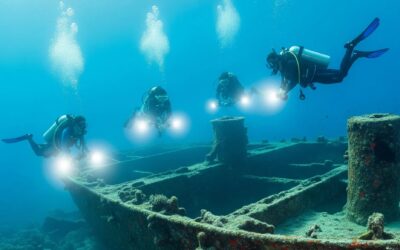A white sand beach merges with a turquoise sea on a dreamy sunset. Where does all this beautiful, soft, white sand come from? In tropical and subtropical areas one of the main suppliers of sand is neither Neptune nor a beached mermaid, but it is the amazing parrotfish. This incredible fish, often ignored by divers, contributes 80% of that white sand that both attracts and comforts us. How does it do it? The how is a little less mystical and elegant.
Parrotfish produces 80% of the sand that we find on tropical beaches. It is estimated that it can generate a tone of sand yearly.
The parrotfish feeds on the algae that cover the dead coral. For this purpose it tears and crushes pieces of dead coral with its powerful jaws. To his stomach comes a mixture of coral and algae. But, for parrotfish, the coral is waste. This waste, poop or defecation is a fine and beautiful white sand that is deposited in the seabed. Due to the currents and the waves, the sand is often transported to the shore. It accumulates forming, over time, beautiful beaches of white sands and turquoise waters.
So, thanks to its feeding the parrotfish not only provides us with beautiful beaches but in turn keeps the reef healthy to prevent the algae from expanding through it. Its role is extremely important for both the aquatic ecosystem and the maintenance of paradisaical beaches. According to scientists, coral reefs would not exist the way we know them today without the parrotfish intervention.
Some species secrete a protective membrane that surrounds them. It has a stinky smell which keeps predators away
Other Interesting facts about the Parrotfish:
- In just one year, one parrotfish may convert a ton of coral into sand
- There are about eighty species of parrot fish, which make up the family of the Scaridae scattered throughout the tropical and subtropical areas of the planet.
- The bumphead parrot fish is the largest member of the family measuring around a meter (4 feet) with a weigh of more than 50 kg (100 pounds).
- It gets its name from its fused-beak structure.
- Parrotfish are generally social and may be found in schools of around 40 individuals. Sometimes an adult breeding male called the supermale leads these schools.
- Throughout his life a parrot fish changes several times of sex. In the event that there is no male holding a haren, the larger female in a short time becomes the new male.
- To be able to rest at night some species secrete a protective membrane that surrounds them. Marine biologists believe that this membrane has a stinky smell that keeps its predators away.
Is the parrotfish endangered? Check out this National Geographic article: To Save Coral Reefs, Start With Parrotfish



